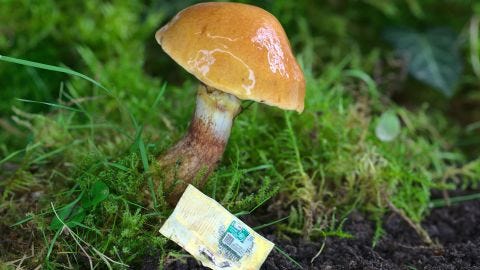But seriously... what can't we make from mushrooms??
Fungi Friday's - November 18th, 2022 - Issue #57
Fungi Friday fam,
We are officially less than one week from turkey day here in the states! Yes, the gorge yourself until you feel sleepy, spend time with those you’re thankful for, turkey day… And let me tell you, i’m quite excited! With next week being a holiday week, we’ll be preparing the publication a day in advance, but not to worry — we’ll still do our best to bring you all of the most interesting, fungi related articles from around the internet. After all, that’s what you’ve come to this tiny corner of the inter-web for, right?
Well if that’s the case, then let’s get into it!
Scientists have used mushrooms to make biodegradable computer chips

As was indicated by the title of this post, there’s a theme this week — building interesting things with fungi and this first feature is nothing short of just that, interesting. You see, new research released this week has shown that mushroom skins could provide a biodegradable alternative to some plastics used in batteries and computer chips, making them easier to recycle. Yes, you read that correctly — mushroom components in your electronics!
Researchers from the Johannes Kepler University in Austria were working on flexible and stretchable electronics, with a focus on sustainable materials to replace non-degradable materials, when they made their discovery, published in the journal Science Advances Friday. They found that there is a mushroom substrate that can insulate and cool the conductive metals sitting on top of it.
According to the research paper, the skin of this mushroom substrate is slightly less insulating than plastic, but it still worked safely and successfully in the electrical circuits, with a thickness akin to paper and the ability to withstand temperatures exceeding 200° Celsius (392° Fahrenheit), making it a good substrate.
Obviously, this new revelation is very much still in the the experimental phase and has a long way from being put into mass production. Even at that though, those involved believe the biodegradable skins could be a sustainable alternative material for use in electronics that don’t require long-lasting electrical circuits, such as wearable health monitors and near-field communication (NFC) tags for electronic devices and they also envision even wider use if they are able to control the mycelium’s growth so that it is uniform and re-produceable.
Buildings Made of Wool and Fungus? Meet the Textile Expert Who’s Making It Happen.
And if mushroom electronics weren’t cool enough, next up let’s discuss mushroom buildings. Imagine you’re standing in an outdoor pavilion, one that’s similar in design to a covered picnic area at a local park or an amphitheater, only instead of support columns made from concrete, wood or stone, this structure is propped up by what appear to be posts of crocheted wool. Above you, a vast expanse of undulating roof is made of the same knitted material. Fungus coats this wool frame, forming the walls and the ceiling, not unlike the way plaster might cover the wood framing of a wall.
This is the premise of an experimental material known as MycoKnit. The goal of this project, to create a building made entirely from fiber. The team behind this experiment is currently testing how knitted materials, such as wool & yarn, might function as the framing for a building while a mixture of straw and mycelium fungus embeds itself onto this knitted fabric to create the rest. Mycelium is composed of individual fibers known as hyphae, which, in nature, create vast and intricate networks through soil, producing things like mushrooms. The amazing thing is that something as basic as fiber can become both the structure (the wool yarn) and the infill (the fungus).
With the assistance of a computer algorithm, the team can virtually assemble and examine the structure stitch-by-stitch in order to predict its shape, before building it and letting the fungus propagate overtop. And the next step in the project, a 12-by-12-by-12-foot MycoKnit prototype that can be fabricated and grown in one place, and then taken on-site to build, like an Ikea kit.
Ultimately they team believes that this new, malleable, lightweight material like MycoKnit offers has the potential to change the very shape of buildings. So if you see some funky looking new structures out there over the next few years, they might just contain fungi!
Want even more? Here are some other interesting, mushroom focused reads of the week:
What happens now that Colorado voters decriminalized magic mushrooms
Can psilocybin — the psychedelic compound in magic mushrooms — help smokers quit?
Exposing Brain Tissue to Psilocybin Provides Insights Into Consciousness, Depression and Anxiety
As always, thank you for reading this weeks edition of Fungi Friday’s! If you enjoyed what you found, please feel free to forward to friends also interested in the Fungi Community!
And if you were forwarded this post and enjoyed what you found, please subscribe below:


